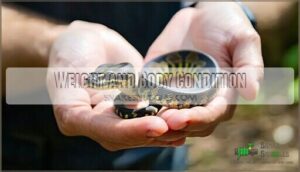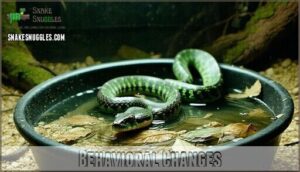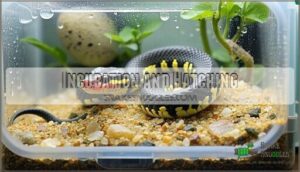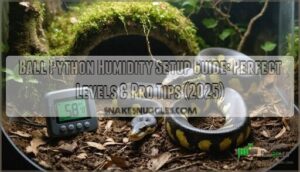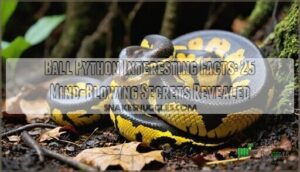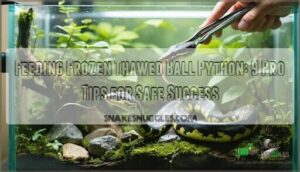This site is supported by our readers. We may earn a commission, at no cost to you, if you purchase through links.
 You’ll find that ball python breeding season varies dramatically between wild and captive environments.
You’ll find that ball python breeding season varies dramatically between wild and captive environments.
Wild ball pythons breed from September to November, laying eggs between April and June.
However, your captive pythons don’t follow nature’s strict schedule—they’ll breed from September through March and lay eggs anytime from April to September.
Think of captive breeding like having a flexible work schedule instead of punching a time clock.
Temperature and lighting changes trigger their reproductive cycle, not just calendar dates.
Your success depends on understanding weight requirements, behavioral cues, and proper conditioning techniques that can make or break your breeding program.
Table Of Contents
- Key Takeaways
- Ball Python Breeding Season
- Selecting a Pair
- Signs of Readiness
- Copulation and Egg Laying
- Incubation and Hatching
- Frequently Asked Questions (FAQs)
- How to tell if your ball python is ready to breed?
- Do ball pythons stop eating during mating season?
- How to tell if a ball python is ovulating?
- What is the seasonality of a ball python?
- What months do ball pythons breed?
- How do you know when a ball python is ready to breed?
- Can you breed ball pythons all year round?
- How does climate affect ball python breeding cycles?
- What role do pheromones play in ball python mating?
- How often can a female ball python safely reproduce?
- Conclusion
Key Takeaways
- You’ll need to meet specific weight requirements before breeding – females must reach at least 1,500 grams and males need 600-800 grams, along with proper body condition and age maturity.
- Your captive ball pythons don’t follow wild breeding schedules – they’ll breed from September through March instead of the wild September-November window, giving you more flexibility in timing.
- You should trigger breeding by cooling nighttime temperatures 5-10 degrees and watch for behavioral signs like male restlessness, female cool-seeking behavior, and feeding refusal during the conditioning period.
- You’ll achieve better success by introducing the male to the female’s enclosure, monitoring for courtship behaviors like tail wrapping and nudging, and maintaining proper incubation conditions at 88-89°F with 90-100% humidity for healthy egg development.
Ball Python Breeding Season
Understanding ball python breeding season timing is your first step toward successful reproduction.
Master the natural cycles—your breeding success starts with perfect timing during those crucial September-to-March months.
The natural python breeding season runs from September through March, when cooler temperatures and shorter daylight hours trigger mating behaviors.
During this period, you’ll notice behavioral changes that signal readiness.
Breeding ball pythons requires attention to breeding ethics and genetic diversity.
Responsible breeders consider market trends and morph selection carefully, avoiding oversaturation of common morphs.
Husbandry innovations have improved success rates substantially.
To guarantee healthy offspring, breeders should prioritize genetic history verification.
Your female will coil protectively around her eggs until hatching—a remarkable display of maternal instinct.
Prepare for challenges like egg binding or infertility, but have incubation equipment ready.
Ball python breeding success depends on understanding these natural cycles and timing your efforts accordingly.
Selecting a Pair
You’ll need to select breeding pairs based on specific age and weight requirements, ensuring your female weighs at least 1,500 grams and your male reaches 600-800 grams.
Proper pair selection sets the foundation for successful breeding, as mismatched snakes can lead to health complications or failed reproduction attempts, which is why proper pair selection is crucial.
Conditioning & Cycling
Proper conditioning sets the stage for successful ball python breeding season.
You’ll need to implement a cooling period that mimics natural brumation effects, dropping nighttime temperatures by 5-10 degrees.
Focus on nutritional prep by gradually increasing your female’s weight while monitoring shed cycles.
A reliable thermostat is vital for maintaining these temperatures.
Complete health assessment guarantees both breeding pairs enter breeding cycles at peak condition for ideal female and male readiness.
Introducing for Mating
After conditioning your breeding pairs, it’s time for the main event. Always introduce the male to the female’s enclosure—this stress reduction technique keeps her comfortable in familiar territory.
Watch for courtship behavior like head bobbing, tail wrapping, and the male’s gentle nudging. These signs indicate mating readiness and compatibility between your breeding pairs. Some males even engage in territorial combat to establish dominance.
Visual confirmation of locks is your goal—when their tails intertwine tightly for hours or even days. Don’t disturb them during this process.
Male rotation between females requires 3+ days rest between pairings. Pairing duration during ball python breeding season typically spans several weeks for ideal enclosure setup success.
Signs of Readiness
You’ll know your ball pythons are ready to breed when they meet specific weight requirements and display distinct behavioral changes.
Females need at least 1,500 grams and proper body condition, while males should reach 600-800 grams and show increased activity during their breeding season.
The weight requirements and behavioral changes are critical indicators of readiness, and understanding these factors is essential for successful breeding.
Weight and Body Condition
Weight and body condition serve as your most reliable indicators for breeding readiness in ball pythons. Your breeding female care starts with achieving the ideal weight – females need at least 1,500 grams, while males can breed around 600-700 grams.
However, don’t rush the growth rate through overfeeding, as this creates health implications that’ll haunt your breeding program. A well-conditioned snake feels firm yet rounded, never overweight or underweight. Regular handling lets you monitor their breeding body condition effectively.
Remember, genetic factors influence how quickly snakes reach breeding weight, so patience pays off. One key indicator is the female’s pre-lay shed, which occurs 3-4 weeks before egg-laying.
Here’s what to assess for female readiness:
- Body shape – rounded but not bulging, with visible muscle definition
- Weight consistency – steady gains over months, not rapid spikes
- Feeding strategies – regular appetite with appropriate prey size
- Overall snake health – active behavior and proper shedding cycles
Behavioral Changes
Beyond weight markers, courtship behavior signals true mating readiness.
Male restlessness intensifies as they pace enclosures and attempt escapes. You’ll witness fascinating courtship rituals including tail-wrapping, nudging, and spur rubbing.
Females display female cool-seeking behavior, gravitating toward cooler spots. Feeding changes become apparent—females often refuse meals during follicle development.
Watch for post-breeding behavior like coiling around water bowls. These breeding rituals showcase python courtship at its finest, revealing reproductive behavior that’s both instinctive and enchanting.
Copulation and Egg Laying
Once you’ve confirmed your ball pythons are ready to breed, you’ll introduce the male to the female’s enclosure and watch for the telltale "lock" that confirms successful mating.
After copulation, your female will undergo a 6-week ovulation period before laying her clutch of eggs, which typically ranges from 4-8 eggs per breeding cycle.
Introducing Your Ball Pythons Together
Once your ball pythons show breeding readiness after the cooling period, it’s time for the main event. Your enclosure setup plays a pivotal role in successful mating.
Introduce the male into the female’s territory – this approach reduces territorial stress and encourages natural courtship behavior. Watch for classic python courtship signs like tail wrapping, gentle nudging, and the male’s characteristic spur rubbing along the female’s body.
These breeding behaviors signal that your ball python breeding season efforts are paying off. Don’t rush the process – pairing duration can vary substantially.
Key factors for successful introductions include:
- Maintaining ideal temperatures during mating attempts
- Providing adequate hiding spots to reduce stress reduction needs
- Monitoring for aggressive behavior between pairs
- Allowing natural male rotation timing between multiple females
- Documenting mating readiness indicators and successful locks
Patience during this phase sets the foundation for healthy egg development ahead.
Egg Laying Behavior
Success breeds excitement, but patience defines the journey ahead. After successful copulation, your female’s behavior shifts dramatically as she prepares for egg laying. She’ll become reclusive and refuse food—completely normal reactions during ovulation.
Watch for the critical prelay shed, occurring 18-26 days before oviposition. This milestone signals egg development is progressing smoothly.
Clutch size typically ranges from 4-10 eggs, though some females produce 1-12 depending on age and condition. Egg fertility becomes apparent during candling, revealing blood vessels in viable eggs.
Maintain 60-80% humidity and 88-90°F temperatures for ideal egg care. Some breeders choose maternal incubation, where females coil protectively around their clutch. Post-lay care involves monitoring the female’s recovery while ensuring proper incubation conditions.
Incubation issues often stem from temperature or humidity fluctuations, so consistency matters most. Understanding the ovulation’s complex process can provide insights into reptile egg-laying behaviors.
Incubation and Hatching
Once your female lays her eggs, you’ll need to transfer them to a properly configured incubator within 24 hours to guarantee successful development.
Setting up the right temperature and humidity conditions becomes critical now, as even small variations can affect hatchling health and survival rates.
Oviposition
When your female ball python enters the egg deposition phase, she’ll display unmistakable signs that’ll make your heart race with anticipation. You’ll witness restless searching behavior, food refusal, and a noticeably swollen appearance near her cloaca. Clutch size typically ranges from 1-11 python eggs, averaging 6 per laying.
Your female’s maternal instincts kick in with fierce determination—she’ll coil protectively around her precious clutch until hatching day arrives.
Some breeders choose to purchase python eggs to expand their breeding stock.
Watch for these emotional milestones during egg laying:
- Her protective coiling around the precious clutch
- The satisfying sight of perfectly formed, leathery eggs
- Relief when she completes laying without dystocia
- Pride in your breeding success
- Excitement for the next phase
Egg morphology matters—healthy eggs appear chalky-white and firm. After oviposition, post-lay care involves careful egg handling and immediate transfer to your incubator. Don’t disturb her natural maternal instincts initially.
Incubation Setup
With your female’s eggs safely laid, creating the perfect incubator setup becomes your next critical mission.
Your egg incubation success hinges on three key factors: temperature control at 88-89°F, humidity levels between 90-100%, and proper substrate choice like vermiculite.
Digital incubators provide the precision you’ll need—temperature fluctuations beyond 1-2 degrees can spell disaster for developing embryos.
Handle eggs gently during transfer, marking their original position with a pencil.
Your incubation temperature directly affects the 55-58 day development period.
Humidity control prevents deadly desiccation while proper egg handling guarantees viability.
Regular egg candling lets you monitor progress and identify potential hatching issues early.
Remember, incubation temperature matters for successful hatching.
Your incubator setup isn’t just housing eggs—it’s nurturing the next generation of healthy ball pythons.
Frequently Asked Questions (FAQs)
How to tell if your ball python is ready to breed?
Your snake’s practically screaming "I’m ready!" when females hit 1,500+ grams and show that telltale "glow before they go" color change.
While males reach 600+ grams and display restless, escape-artist behavior during breeding season, signaling they are also ready.
Do ball pythons stop eating during mating season?
Yes, your ball python will likely reduce or stop eating during mating season.
Both males and females often fast due to hormonal changes and breeding behaviors, so don’t panic if they refuse meals temporarily.
How to tell if a ball python is ovulating?
Like watching a balloon slowly inflate, you’ll notice your female’s midsection swelling dramatically.
She’ll develop a distinct "glow" color change, seek cooler spots, refuse food, and exhibit restless behavior as follicles reach maturity.
What is the seasonality of a ball python?
Ball pythons follow West African seasonal patterns in captivity.
You’ll trigger breeding by cooling temperatures to 78-80°F from November through February, then warming up.
This mimics their natural dry season breeding cycle.
What months do ball pythons breed?
Imagine this: your scaly friend’s biological clock starts ticking when temperatures drop!
You’ll see breeding activity peak from November through February, with courtship beginning in late fall and egg-laying wrapping up by early spring. Complete concepts
How do you know when a ball python is ready to breed?
Check your female’s weight—she needs 1,500+ grams and should be 27-31 months old.
Watch for the "glow before they go" color change and pre-lay shed indicating she’s ready to breed.
Can you breed ball pythons all year round?
Imagine trying to breed your snake in July—you’d likely fail.
No, you can’t breed ball pythons year-round.
They’re seasonal breeders who naturally mate during cooler months, typically November through March when temperatures drop.
How does climate affect ball python breeding cycles?
Climate directly triggers your ball python’s breeding instincts.
Cooler temperatures (75-80°F) during winter months simulate natural dry seasons, prompting reproductive behaviors.
Without seasonal temperature drops, you’ll rarely see successful breeding cycles in captivity.
What role do pheromones play in ball python mating?
Like invisible threads weaving through the air, chemical signals orchestrate your ball python’s romantic dance.
You’ll notice males detecting female pheromones through scent-tracking, triggering courtship behaviors that guide successful mating encounters during breeding season.
How often can a female ball python safely reproduce?
Female ball pythons can safely reproduce every other year, giving them time to recover between breeding cycles.
Annual breeding stresses their bodies and depletes calcium reserves, potentially causing health issues and reduced egg quality, as it can lead to health issues.
Conclusion
Like a Victorian naturalist painstakingly documenting specimens, you’ve now mastered the intricate timing of ball python breeding season.
Your success hinges on recognizing weight requirements, behavioral cues, and environmental triggers that signal readiness.
Remember, captive pythons don’t follow wild schedules—they’ll breed September through March when conditions are right.
Monitor your pairs closely, maintain proper temperatures, and trust the process.
With patience and attention to detail, you’ll consistently produce healthy clutches year after year.
- https://www.sciencedirect.com/topics/agricultural-and-biological-sciences/python-regius
- https://www.researchgate.net/publication/351525106_A_Survey_of_Husbandry_and_Breeding_Techniques_in_the_Ball_Python_Python_regius_Pet_Trade
- https://pmc.ncbi.nlm.nih.gov/articles/PMC6021098/
- https://www.mdpi.com/2073-4425/14/9/1744
- https://journals.plos.org/plosone/article?id=10.1371/journal.pone.0199377


